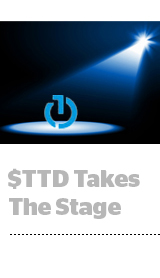 The Trade Desk reported net revenue of $79.4 million in the third quarter, a 50% jump over the same period last year.
The Trade Desk reported net revenue of $79.4 million in the third quarter, a 50% jump over the same period last year.
The Trade Desk increased its forecasted revenue for 2017 from $303 million to $306 million, and has beaten and increased its revenue guidance in all five quarters since its IPO.
The company’s first quarters “have been about gaining trust with Wall Street,” said founder and CEO Jeff Green. Despite the public market’s pessimism over ad tech stocks, Green said the prospects for an independent DSP are better than many industry analysts would credit.
For one thing, the “myths” around Google and Facebook’s usurpation of digital media growth budgets obscure the fact that dollars flow within digital, Green said, like from non-programmatic to programmatic, and away from ad networks and less efficient display channels like banners to native.
And other revenue streams, like The Trade Desk’s data marketplace, aren’t directly challenged by competitors. Data is a marginal piece of overall revenue, Green said, but it’s growing fast and is already the single biggest rev-share generator for multiple data providers listed in The Trade Desk’s marketplace.
The Trade Desk also sees a substantial runway overseas, with international revenue outpacing growth in the US.
China is also a more mature market for OTT inventory, Green said, since subscription services like Netflix and Amazon are priced out in favor of free, ad-supported media.
But OTT and broadcast media is growing fast for The Trade Desk with connected TV spending up 159% year-over-year. That line of business could be The Trade Desk’s bastion against the long-term threat posed by walled gardens.
The streaming TV service Roku, for instance, had a strong first quarter since its IPO, with The Trade Desk as one of its biggest programmatic demand sources, Green said.
And legacy broadcasters represent a huge opportunity to leverage scale beyond walled gardens.
Within some of the largest broadcast media companies, executives “are looking for alternatives to walled gardens as partners on the demand side,” Green said. “Those companies are asking us, ‘Can you be our biggest demand source?’”












